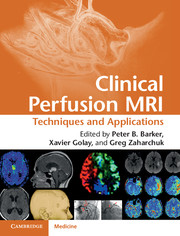Book contents
- Frontmatter
- Contents
- List of Contributors
- Foreword
- Preface
- List of Abbreviations
- Section 1 Techniques
- Section 2 Clinical applications
- 8 MR perfusion imaging in neurovascular disease
- 9 MR perfusion imaging in neurodegenerative disease
- 10 MR perfusion imaging in clinical neuroradiology
- 11 MR perfusion imaging in oncology: neuro applications
- 12 MR perfusion imaging in oncology: applications outside the brain
- 13 MR perfusion imaging in breast cancer
- 14 MR perfusion imaging in the body: kidney, liver, and lung
- 15 MR perfusion imaging in cardiac diseases
- 16 MR perfusion imaging in pediatrics
- Index
- References
11 - MR perfusion imaging in oncology: neuro applications
from Section 2 - Clinical applications
Published online by Cambridge University Press: 05 May 2013
- Frontmatter
- Contents
- List of Contributors
- Foreword
- Preface
- List of Abbreviations
- Section 1 Techniques
- Section 2 Clinical applications
- 8 MR perfusion imaging in neurovascular disease
- 9 MR perfusion imaging in neurodegenerative disease
- 10 MR perfusion imaging in clinical neuroradiology
- 11 MR perfusion imaging in oncology: neuro applications
- 12 MR perfusion imaging in oncology: applications outside the brain
- 13 MR perfusion imaging in breast cancer
- 14 MR perfusion imaging in the body: kidney, liver, and lung
- 15 MR perfusion imaging in cardiac diseases
- 16 MR perfusion imaging in pediatrics
- Index
- References
Summary
Introduction
The application of perfusion MRI in clinical neuro-oncology hinges upon the differential expression of angiogenic processes within neoplastic tissues when compared with surrounding normal brain. All neoplastic tissues rely upon the formation of new blood vessels, a biological process known as angiogenesis, to constantly supply nutrients and remove metabolic waste materials. Angiogenesis is a complex biological process that is upregulated by a number of cytokines, including vascular endothelial growth factor (VEGF), which is released within tumors, endothelial cells, and surrounding immune cells [1–5]. As tumor growth occurs beyond its existing blood supply, regional cellular hypoxic and hypoglycemic conditions ensue. This change within the cellular microenvironment promotes the transcription of VEGF that ultimately results in endothelial mitosis, cellular migration, and the formation of new microvasculature, thereby improving tumor nutrient supply that is essential to continued tumor growth and development [1–7].
VEGF expression and angiogenesis is known to vary by tumor type and grade. VEGF expression within gliomas and meningiomas has been associated with increased tumor grade and expression of histologically aggressive vascular features [8–11]. Tumor-related VEGF expression ultimately leads to the abnormal development of microvasculature, resulting in elevated vascular density with disrupted flow characteristics [12–14]. The observation that angiogenesis plays a critical role in tumor growth has led to the development of therapeutic agents which directly inhibit angiogenic activity. The clinical implementation of anti-angiogenic chemotherapeutics has necessitated histological and imaging-based quantification of angiogenic activity.
- Type
- Chapter
- Information
- Clinical Perfusion MRITechniques and Applications, pp. 204 - 237Publisher: Cambridge University PressPrint publication year: 2013
References
- 2
- Cited by



